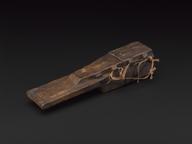

Kelvin's Harmonic Analyser




Kelvin harmonic analyser by R.W. Munro, London, in glass case.
Kelvin's harmonic analyser, 1878. The machine was Invented by William Thomson, Lord Kelvin, (1824-1907), a pioneering Irish physicist. The harmonic analyser was designed to analyse graphical records of daily changes in atmospheric temperature and pressure. It was brought into use by the Meteorological Office in 1878. The tracing point is taken along the curve to be analysed, and its movement causes the seven discs to rotate. Rolling spheres communicate this motion to the recording rollers.
Details
- Category:
- Mathematics
- Object Number:
- 1946-343
- Materials:
- brass (copper, zinc alloy) and steel (metal)
- Measurements:
-
Overall: 600 mm x 2680 mm x 460 mm, 380 kg
- type:
- harmonic analyser
- credit:
- Air Ministry, Meteorological Office




